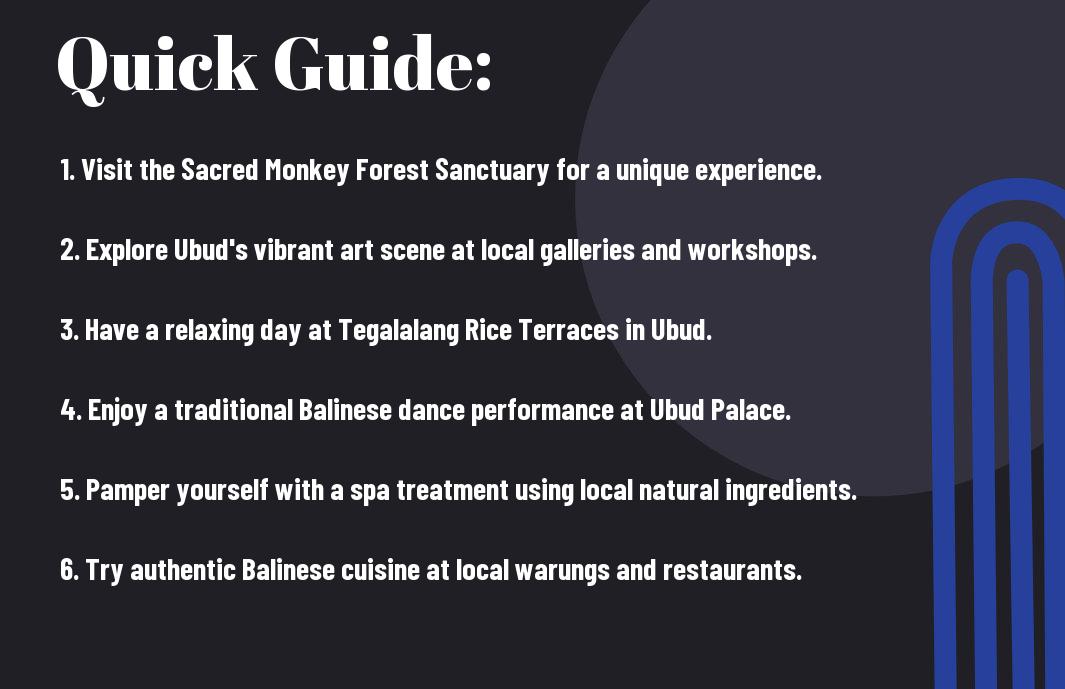Indonesia is home to Ubud, a mystical town nestled in the lush jungles of Bali. Known for its serene landscapes, rich cultural heritage, and vibrant arts scene, Ubud is a hidden gem waiting to be discovered. In this ultimate guide, we will probe into the secrets of this enchanting destination, from must-visit attractions to safety tips to make the most of your time in Ubud.
Prepare to be mesmerized by Ubud’s breathtaking rice terraces, ancient temples, and traditional Balinese dance performances. But be cautious of the monkeys at the Sacred Monkey Forest Sanctuary, known for their mischievous antics. Make sure to indulge in the local cuisine, explore the vibrant markets, and partake in rejuvenating yoga and meditation sessions. While the town exudes tranquility, it’s crucial to stay vigilant of your surroundings, especially when navigating the bustling streets and haggling with vendors.
Whether you seek spiritual enlightenment, artistic inspiration, or simply a serene escape from the chaos of daily life, Ubud offers a truly transformative experience. Embrace the warmth of the Balinese hospitality, immerse yourself in the local customs, and begin on adventures that will create lasting memories. With this comprehensive guide, you’ll be well-equipped to uncover the magic of Ubud and create an unforgettable journey in Indonesia’s hidden gem.
Key Takeaways:
- Cultural Hub: Ubud is known as the cultural heart of Bali, offering an array of art galleries, museums, and traditional Balinese performances.
- Nature’s Paradise: Explore lush rice terraces, stunning waterfalls, and sacred forests surrounding Ubud, providing a serene and picturesque backdrop.
- Wellness Retreat: Ubud is a top destination for wellness seekers, with its numerous yoga studios, spas, and healthy eateries offering a holistic experience.
- Shopping Haven: Discover vibrant markets and boutique shops in Ubud, where you can shop for unique handicrafts, textiles, and local artwork.
- Culinary Delights: Indulge in authentic Balinese cuisine at Ubud’s cozy cafes, fancy restaurants, and traditional warungs, showcasing the region’s diverse flavors.
- Adventure Activities: Embark on exciting outdoor adventures such as white-water rafting, cycling through villages, hiking Mount Batur, or trying traditional Balinese cooking classes.
- Spiritual Essence: Ubud is a spiritual haven with its numerous temples, yoga retreats, and meditation centers that offer a tranquil atmosphere for spiritual seekers.
Ubud’s Rich History
Even amidst the bustling tourism and modernity, Ubud is steeped in a rich history that dates back centuries. Exploring the roots of this cultural oasis offers a deeper understanding of its allure and significance in Indonesia.
The Origins of Ubud
Little is known about the exact origins of Ubud, but archaeological findings suggest that the area has been inhabited for over a thousand years. The early settlers in Ubud were believed to be Hindu priests who sought the tranquility of the surrounding forests for meditation and spiritual practices. Over time, Ubud evolved into a small village known for its artistic community and traditional crafts.
The landscape of Ubud, with its lush green rice terraces and flowing rivers, has inspired generations of artists and writers. The peaceful ambiance of the region provided a fertile ground for creativity, attracting painters, dancers, and musicians who sought solace and inspiration in Ubud’s natural beauty.
Ubud’s history is intertwined with its rich tapestry of cultural traditions, from intricate temple ceremonies to vibrant dance performances. The preservation of these age-old customs has contributed to Ubud’s unique identity as a center for art, spirituality, and traditional practices.
The Royal Legacy
Ubud’s Royal Legacy dates back to the 8th century when the Javanese Hindu priest Rsi Markendaya established the first dynasty in Ubud. The Ubud ruling family, known as the Puri Saren Agung, played a significant role in shaping the region’s cultural landscape and promoting the arts.
Ubud’s royal connections can still be seen today in the elaborate palaces and temples that dot the town. The Puri Saren Agung Palace, in the heart of Ubud, is a testament to the royal family’s influence and patronage of the arts. The intricate carvings, stone statues, and traditional architecture reflect the grandeur of Ubud’s royal past.
Today, the descendants of the Ubud royal family continue to uphold their traditions and participate in ceremonial events that honor their heritage. The royal legacy adds a layer of mystique and refinement to Ubud, reminding visitors of the town’s regal history and cultural significance.
The Rise of Ubud as a Cultural Hub
Another pivotal moment in Ubud’s history was its transformation into a cultural hub in the early 20th century. The arrival of foreign artists and scholars brought new perspectives and ideas to Ubud, sparking a renaissance in traditional arts and culture.
Ubud became a magnet for creatives seeking inspiration and a deeper connection to Balinese traditions. The establishment of art schools and cultural institutions further solidified Ubud’s reputation as a haven for artists and intellectuals, leading to a flourishing creative community that continues to thrive today.
To this day, Ubud remains a melting pot of artistic expression and cultural exchange, drawing visitors from around the world to experience its unique blend of tradition and innovation. The vibrant art scene, lively festivals, and spiritual retreats contribute to Ubud’s status as a global cultural destination.
Understanding Ubud
All visitors to Ubud can benefit from a good understanding of the area. Ubud, a town in central Bali, is known for its traditional crafts and dance. It’s located amongst rice paddies and steep ravines in the central foothills of the Gianyar regency. The town is made up of 14 banjar, the smallest local administrative unit in Indonesia, each consisting of a few hundred people.
Geographical Layout
Clearly, Ubud is a picturesque town surrounded by lush greenery and serene landscapes. Its geographical layout spans over a relatively small area, making it easy for visitors to explore on foot or by bicycle. The town center is bustling with activity, from vibrant markets selling handmade crafts to traditional Balinese dance performances held in the evening.
Cultural Significance
There’s a rich cultural heritage in Ubud that is evident in its art, music, and dance. The town has long been a center for traditional Balinese arts and crafts, attracting artists and performers from all over the world. Ubud is also known for its spiritual significance, with numerous temples and yoga studios offering a tranquil escape for those seeking inner peace and self-discovery.
Ubud’s cultural significance extends beyond its artistic and spiritual offerings. The town’s strong sense of community and traditional values are evident in its unique ceremonies and rituals, which are still practiced to this day. Visitors to Ubud can immerse themselves in the local culture by attending traditional ceremonies, exploring the intricate temples, and interacting with the friendly locals.
The Modern Face of Ubud
Layout of Ubud has evolved in recent years to cater to the growing number of tourists seeking a blend of tradition and modern amenities. The town now boasts a range of accommodation options, from luxury resorts to budget guesthouses, as well as trendy cafes, boutiques, and art galleries. Ubud’s streets are lined with shops selling everything from traditional handicrafts to trendy fashion items, catering to diverse tastes and preferences.
One of the most striking aspects of Ubud’s modern face is its thriving wellness industry, offering everything from yoga retreats to holistic healing treatments. Visitors can indulge in spa therapies, organic dining experiences, and wellness workshops to rejuvenate their mind, body, and soul. Ubud has become a sanctuary for those seeking a holistic approach to health and well-being, with a growing number of wellness centers and eco-friendly practices in place.
Ubud stands out as a unique destination that seamlessly blends tradition with modernity, offering visitors a harmonious retreat from the hustle and bustle of everyday life. With its rich cultural heritage, picturesque landscapes, and thriving arts scene, Ubud has something to offer every traveler. Whether you’re seeking spiritual enlightenment, artistic inspiration, or simply a relaxing getaway, Ubud is sure to captivate your senses and leave a lasting impression.
Preparing for Your Trip to Ubud
Keep your travel plans on track with the help of the Ultimate Ubud Travel Guide: Where to Stay and Must-Do …. This comprehensive guide will provide you with all the information you need to make the most of your time in this enchanting destination. From accommodation options to top activities, this guide has got you covered.
Best Times to Visit
For the best experience in Ubud, plan your visit during the dry season from April to October. The weather is pleasant, with clear skies and lower humidity, making it ideal for exploring the lush landscapes and cultural attractions that Ubud has to offer. However, keep in mind that this is also the busiest time of year, so book your accommodations and activities in advance to avoid any last-minute hassles.
Packing Essentials
To make the most of your trip to Ubud, pack light, breathable clothing suitable for the warm and humid tropical climate. Don’t forget necessarys like sunscreen, insect repellent, a reusable water bottle, and comfortable walking shoes for exploring the town and surrounding areas. It’s also a good idea to carry a light rain jacket or umbrella, as showers are common, especially during the wet season from November to March.
One necessary item you shouldn’t overlook is a sarong or scarf to cover up when visiting temples or attending traditional ceremonies. Respect for local customs is important in Ubud, so be mindful of your attire when venturing out to these sacred sites.
Managing Expectations: Pros and Cons of Visiting Ubud
One of the pros of visiting Ubud is the serene and tranquil atmosphere that surrounds the town. The beautiful rice terraces, lush jungles, and spiritual vibes create a peaceful ambiance that is perfect for relaxation and rejuvenation. Additionally, Ubud is a hub for wellness activities, offering yoga classes, meditation retreats, and spa treatments to nourish your body and soul.
On the flip side, one of the cons of visiting Ubud is the increasing commercialization and crowds, especially in the central areas. The town has become a popular tourist destination, attracting visitors from all over the world, which can sometimes detract from the authentic Balinese experience. Traffic can also be a challenge, particularly during peak hours, so be prepared for some congestion on the roads.
Visiting Ubud Tips:
– Avoid driving in the town center due to narrow streets and heavy traffic.
– Watch out for aggressive monkeys in the Monkey Forest, keep your belongings secure.
– Respect local customs and traditions, especially when visiting temples.
– Stay hydrated and protect yourself from the sun to avoid heat exhaustion.
Transport and Accommodation
Getting to and Around Ubud
Now, let’s talk about getting to and around Ubud, the cultural heart of Bali. A little-known fact is that Ubud does not have its own airport. The nearest international airport is Ngurah Rai International Airport in Denpasar, approximately a 1.5-hour drive away. To reach Ubud from the airport, you can arrange a pre-paid taxi or hire a private driver. Another popular option is to rent a scooter, which gives you the flexibility to explore the surrounding areas at your own pace.
One important thing to note is that traffic can be quite congested in and around Ubud, especially during peak tourist seasons. It’s crucial to plan your travel times carefully to avoid getting stuck in traffic jams. If you’re not comfortable driving a scooter or navigating the chaotic traffic, there are plenty of taxi services and ride-hailing apps available in Ubud that can take you around town.
For those looking for a more immersive experience, there are also bicycle rentals available in Ubud. Cycling through the lush green landscapes and charming villages is a unique way to explore the region. Just make sure to wear a helmet and stay hydrated, as the tropical climate can be quite unforgiving.
Finding the Perfect Place to Stay
Now, let’s explore into finding the perfect place to stay in Ubud. An increasing number of travelers are opting for eco-friendly accommodations in Ubud, such as traditional Balinese villas or eco-resorts nestled in the heart of nature. These choices not only offer a more sustainable lodging option but also provide a tranquil retreat from the hustle and bustle of city life.
When choosing your accommodation in Ubud, consider factors such as proximity to cultural attractions, accessibility to restaurants and shops, and on-site amenities like swimming pools or yoga studios. Many hotels and guesthouses in Ubud also offer complimentary shuttle services to the town center, making it convenient for guests to explore the area without worrying about transportation.
Transportation arrangements are often an added benefit provided by accommodations in Ubud. Whether you prefer the convenience of a private car or the local experience of riding a scooter, most places will assist you in arranging transportation for your excursions. Don’t hesitate to inquire about safe and reliable transport options with your chosen accommodation.
Exploring the Wonders of Ubud
Unlike the bustling beaches of Bali, Ubud offers a serene retreat into the heart of Indonesian culture and spirituality. One of the prime attractions in Ubud is its plethora of temples and shrines that dot the landscape, each with its unique significance and charm. To make the most of your Ubud experience, a step-by-step guide to exploring these sacred sites is important.
Step-by-Step Guide to Ubud’s Temples and Shrines
| If | Then |
| Start your day early | Visit the iconic Goa Gajah, also known as the Elephant Cave |
| Immerse yourself in history | Explore the intricately carved stone shrines at Gunung Kawi |
| Experience tranquility | Don’t miss the serene beauty of Tirta Empul, the holy water temple |
The Art and Craft Scene
With a rich history of artistry and craftsmanship, Ubud is a haven for art lovers and collectors alike. The vibrant marketplaces and galleries showcase a wide range of traditional and contemporary pieces, from intricate wood carvings to colorful batik textiles. Immerse yourself in the local art scene by attending a traditional dance performance or participating in a hands-on craft workshop.
To truly appreciate the depth of talent in Ubud, take a stroll through the village of Peliatan, known for its artist communities and picturesque surroundings. Here, you can witness skilled artisans at work, creating everything from intricate silver jewelry to traditional Balinese paintings. The art and craft scene in Ubud is a testament to the island’s rich cultural heritage and creative spirit.
Ubud’s Natural Beauty
Ubud’s lush landscapes and verdant rice paddies make it a paradise for nature enthusiasts. From the stunning Tegalalang rice terraces to the majestic Mount Batur volcano, the natural beauty of Ubud is truly awe-inspiring. Explore the Campuhan Ridge Walk for panoramic views of the surrounding countryside or take a refreshing dip in the Tegenungan Waterfall for a rejuvenating experience.
Ubud is also home to the sacred Monkey Forest, where visitors can interact with playful macaques amidst ancient temple ruins. The harmonious blend of nature and spirituality in Ubud creates a unique and unforgettable experience for travelers seeking serenity and adventure in equal measure.
Exploring Ubud allows you to discover a harmonious blend of culture, art, and nature. With its diverse attractions and serene surroundings, Ubud offers a truly immersive experience that will leave you enchanted and inspired.
The Culinary Journey
Your culinary journey in Ubud will be a feast for your senses, with a diverse range of flavors that will tantalize your taste buds. Ubud is renowned for its vibrant food scene, which blends traditional Balinese cuisine with modern twists and international influences.
One of the must-try dishes in Ubud is Babi Guling, which is roasted suckling pig. This iconic Balinese dish is prepared with a blend of rich spices and herbs, resulting in incredibly flavorful and tender meat. Be sure to head to Ibu Oka, a famous spot known for serving some of the best Babi Guling in Ubud.
For those with a sweet tooth, don’t miss out on trying traditional Balinese desserts like Dadar Gulung (pandan crepes filled with coconut and palm sugar) or Laklak (rice flour cake with coconut and palm sugar). These desserts offer a unique blend of flavors that showcase the richness of Indonesian ingredients.
Ubud is also a haven for vegetarians and vegans, with an abundance of cafes and restaurants that cater to plant-based diets. You can savor dishes made with fresh organic produce sourced from local farms, ensuring that your culinary experience is not only delicious but also environmentally conscious.
When dining in Ubud, be cautious of street food vendors and choose established eateries with good hygiene practices to avoid food-borne illnesses. It’s vital to prioritize your health and well-being while exploring the culinary delights of Ubud.
Overall, Ubud is a food lover’s paradise, offering a vast array of dining options that cater to every palate. Whether you’re craving traditional Balinese fare, international cuisine, or healthy plant-based dishes, Ubud has something for everyone. So, commence on a culinary journey through Ubud and let your taste buds discover the flavors of Indonesia’s hidden gem.
FAQ
Q: What makes Ubud a hidden gem in Indonesia?
A: Ubud is a hidden gem in Indonesia because of its lush green landscapes, rich cultural heritage, and vibrant arts scene. It offers a peaceful retreat away from the hustle and bustle of popular tourist destinations.
Q: When is the best time to visit Ubud?
A: The best time to visit Ubud is during the dry season, which runs from April to September. This period offers pleasant weather and clear skies, perfect for exploring the town and its surroundings.
Q: What are the must-visit attractions in Ubud?
A: Some of the must-visit attractions in Ubud include the Sacred Monkey Forest Sanctuary, Tegalalang Rice Terraces, Ubud Art Market, Goa Gajah (Elephant Cave), and Tirta Empul Temple.
Q: What activities can one indulge in while in Ubud?
A: Visitors to Ubud can participate in a range of activities such as yoga and meditation retreats, traditional Balinese dance performances, cycling through rice paddies, white water rafting, and exploring local art galleries.
Q: Where can one experience traditional Balinese cuisine in Ubud?
A: To experience traditional Balinese cuisine in Ubud, head to local warungs (small family-owned eateries), where you can savor dishes like Babi Guling (suckling pig), Bebek Betutu (slow-cooked duck), and Lawar (minced meat salad).
Q: What are some recommended accommodations in Ubud?
A: Some recommended accommodations in Ubud include Viceroy Bali for luxury travelers, Bisma Eight for a boutique experience, and Yoga Barn for budget-conscious travelers looking for a wellness retreat.
Q: How can one get around Ubud?
A: The most common modes of transportation in Ubud are motorbike rentals, taxis, and private drivers. For short distances, walking or cycling can also be enjoyable ways to explore the town and its surroundings.




